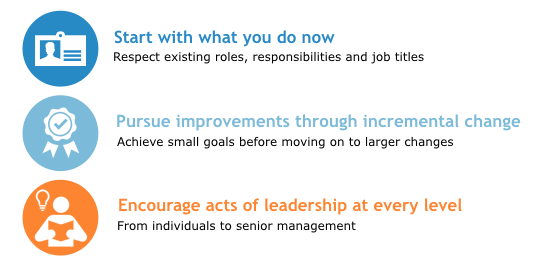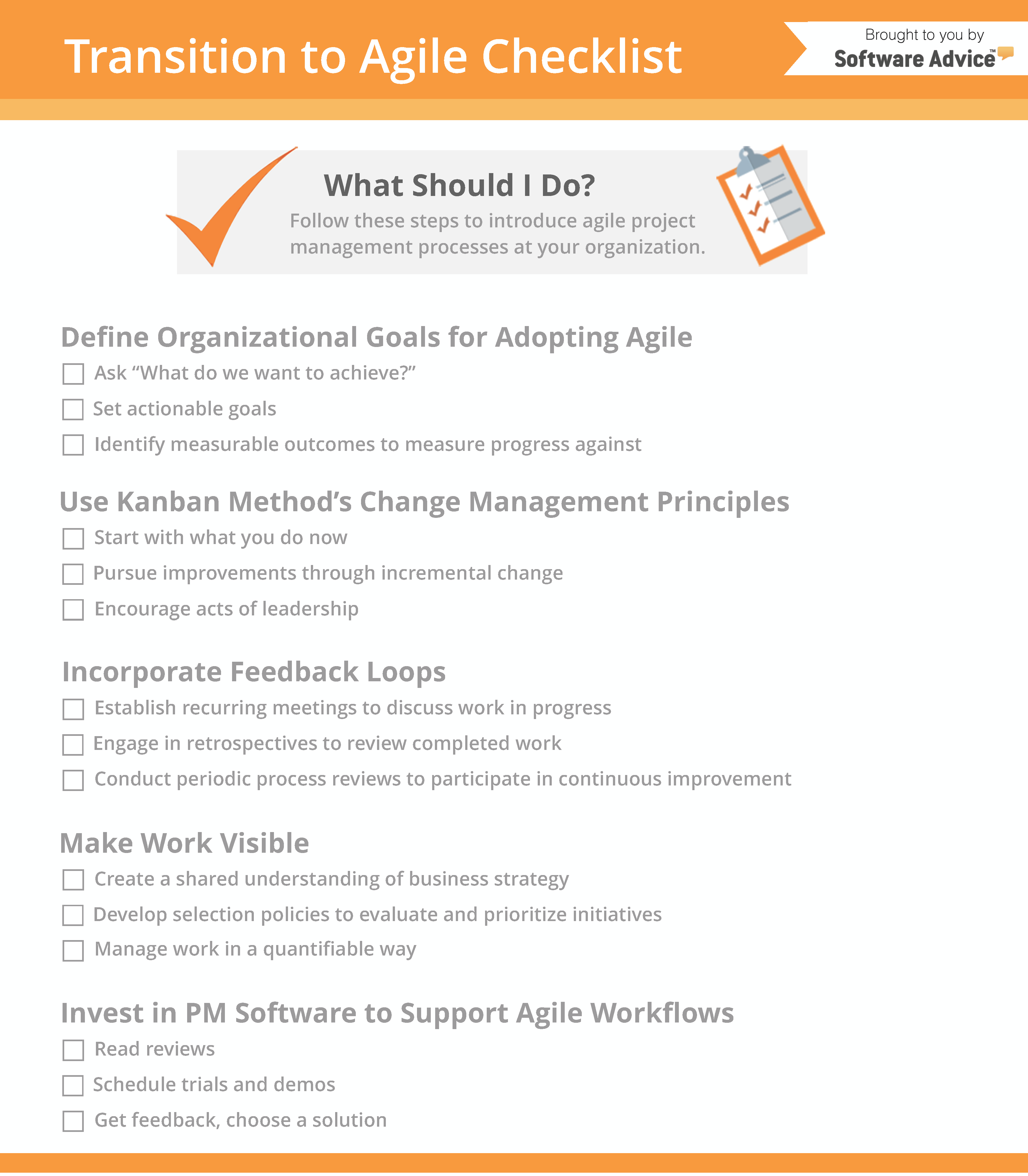How to Prepare Your SMB For a Transition to Agile Processes
Remember the sci-fi movie Edge of Tomorrow? Tom Cruise, fighting off an alien invasion while stuck in a time loop? Oh, and it’s set in the year 2020.
That’s right, folks. In less than five years, a time that was once fuel for a futuristic fantasy will be our reality. And, while it’s unlikely we’ll find ourselves in the midst of an alien invasion, we should expect and prepare for significant changes to disrupt the project management industry.
For example, Gartner predicts that by 2020, “60% of current IT project managers will be replaced by other leadership roles, as enterprises move into digital business.”
An important factor in this change, according to senior research analyst Mbula Schoen, is that “the traditional project manager role will be diminished in the face of agile, self-managed teams.” (The full report, “Predicts 2016: PPM Capabilities and Solutions Are Not Keeping Pace With Digital Transformation,” is available to Gartner clients.)
If you’re a traditional project manager, words such as “replaced,” “diminished” and “self-managed” may have you feeling like you’d rather take on aliens than a future in project management. But don’t give up hope yet:
In this guide we’ll explain what this prediction means for small and midsize businesses (SMBs) and outline steps to help traditional project managers adopt agile processes.
Here’s what we’ll cover:
Leadership Skills SMBs Should Focus On For 2020
4 Best Practices For Introducing Agile Workflows
The Project Manager Role vs. Self-Managed Teams
Next Steps And Downloadable Checklist
What Is Digital Business?
Gartner defines digital business as “the creation of new business designs by blurring the digital and physical worlds.” This occurs through greater connectivity and sharing of data between people, businesses and things (e.g., through the internet of things (IoT) and advanced analytics).
These developments will disrupt existing business models across all industries and business size. SMBs and enterprises alike should embrace these changes rather than fearing them.
Leaders who actively take steps to develop digital business skills will find themselves with a competitive advantage come 2020, when the full effects of the digital business transformation are expected to hit.
Leadership Skills SMBs Should Focus on for 2020
To remain competitive amid the ongoing digital transformation, businesses of any size must be able to recognize and quickly respond to changing market conditions.
To do so, analyst Shoen advocates that organizations:
Develop a change management strategy
Adopt hybrid or fully agile processes
Value versatile leaders who can drive cross-departmental initiatives
What this means for your SMB: If you’re an IT project manager, Gartner’s prediction doesn’t mean that you’re out of a job. Instead, look at it Shoen’s recommendations as a road map for the skills you should develop over the next few years.
In fact, as an SMB project manager, you’re in a better position than many enterprise project managers. Due to limited resources, chances are that you already wear many hats and as such, have developed a multifaceted skill set rather than a specialized focus.
Leverage this advantage and seek out opportunities to further develop your competencies. Finally, take steps to increase your knowledge and comfort level with agile project management processes.
For a deeper dive into the qualities that define a highly valuable project manager, head over to our recent article.
4 Best Practices for Introducing Agile Workflows
For real-world best practices on introducing agile processes at SMBs, we spoke with Matthew Philip, director of agile coaching at Asynchrony Labs (an IT consulting firm that specializes in agile transformation services).
(See the Next Steps section at the end for a downloadable checklist of these best practices.)
1. Define your organizational goal for adopting agile
One of the first questions Philip asks an organization interested in agile is whether they have a defined organizational goal, i.e., a specific outcome they are looking to achieve. Without a benchmark to work toward, it can be hard to review progress and nearly impossible to measure success.
Additionally, this question shows Philip if an organization thinks that agile is a magic bullet that will solve all their problems, or if they truly understand the undertaking. With actionable goals in place, he can help guide the team or organization toward sustainable change.
2. Pursue incremental, evolutionary improvements
Philip says one of the best ways to promote sustainable change is through the Kanban method’s change management principles. These principles help combat resistance to change and can help pave the way for a successful agile transformation.
Kanban Method’s Change Management Principles

The first principle in particular is about respecting and understanding the aspects of a person’s job that are closely tied to their identity. You don’t need to upend everything at once.
“That can be very unsettling for people, and they can resist any further change that goes on from there,” says Philip.
3. Incorporate feedback loops
Next, Philip says it’s important to set up reflective improvement frameworks. More than anything else, feedback loops help to catalyze change.
Examples of feedback loops that managers can help teams incorporate into their workflows include:
Standup: A daily status meeting that is short enough that participants can remain standing (typically around 15 minutes). Teams discuss what they worked on the day before, what they have planned for today and any difficulties hindering their progress.
Service delivery review: A weekly or biweekly meeting to review departmental progress and performance.
Operations review: Multiple teams gather to share performance data for recent initiatives, communicate big wins and any issues they’re having and participants can collaborate on solutions.
Retrospective: Teams collaborate on completed initiatives and look for ways to improve delivery for future work efforts.
“All of these are feedback loops that really allow a team to bootstrap itself to always be improving,” says Philip.
4. Make work visible
The visual depiction of work is critical to a successful agile transition, says Philip. This helps create a shared understanding about what is important for an organization, allowing for open conversations about policy, processes and potential for improvement.
This transparency allows teams to manage work in a much more quantifiable way by asking:
What important initiatives should we be working on first?
What are our selection policies about initiatives we choose to work on?
How do we improve toward delivering our work for our stakeholders?
There are various Kanban or Scrum tools that can help agile teams map out and visualize their workflows. For help evaluating which method is the best fit for your team, download our free e-book.
The Project Manager Role vs. Self-Managed Teams
Finally, let’s address Shoen’s observation that in the future, the traditional role of the project manager will diminish in the face of agile, self-managed teams.
This doesn’t mean that project managers cease to exist in agile organizations. Rather that their traditional role as supervisor gives way to something more akin to that of a mentor or facilitator.
Additionally, as organizations adopt agile processes, managers may shift responsibilities and take on the role of another leadership position, such as a product owner or a service request manager.
According to Philip, the goal for any agile leader—whether they’re project managers, scrum masters, service delivery managers or coaches—is to create aligned autonomy. This means giving teams a sense of what’s important in the organization and then giving them the autonomy to make decisions within that.

“In this new world, the manager role isn’t telling people what to do so much as it is making things highly visible, making organizational goals and objectives measurable and giving teams freedom within structure to achieve those objectives.”
Matt Philip, director of agile coaching at Asynchrony Labs
How important is this topic to your business?
Very important
Moderately important
Minimally important
Not important
 Loading ...
Loading ...
Next Steps and Downloadable Checklist
As 2016 winds to a close, it’s important to start thinking strategically how to set up your team and your organization for success in 2017 and beyond. Keep Gartner’s recommendations in mind and take steps to master change management and adopt hybrid or fully agile workflows.
If you’re interested in learning about the tools available to help SMBs streamline their workflows, head over to our buyer’s guide for more information. Once there you can check out our PM FrontRunners quadrant for a list of leading systems or use our interactive tool to filter products according to your needs, such as industry requirements or price point.
And, don’t forget to download your copy of the best practices for introducing agile workflows we’ve discussed here:
